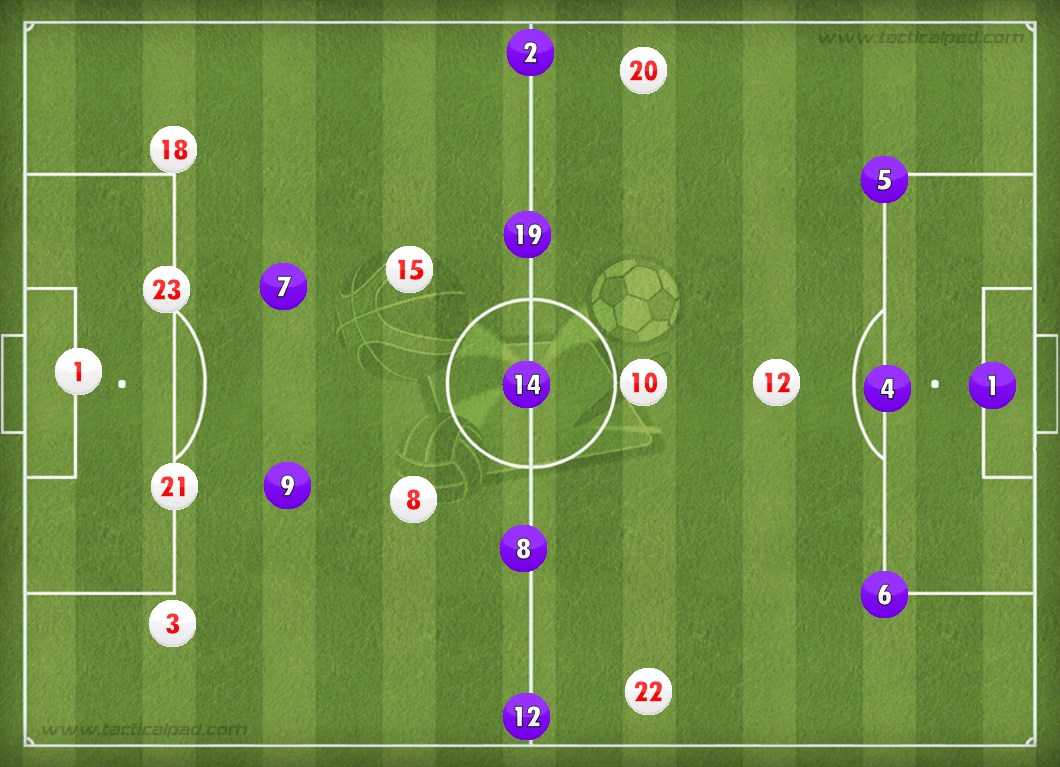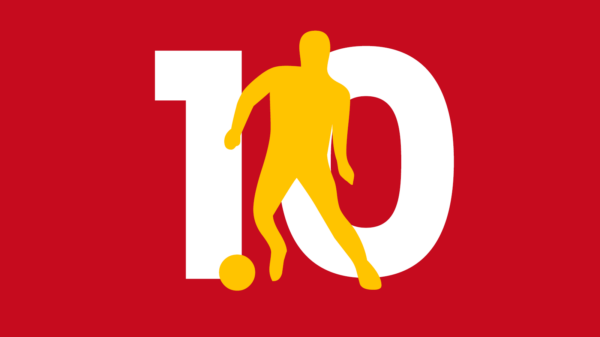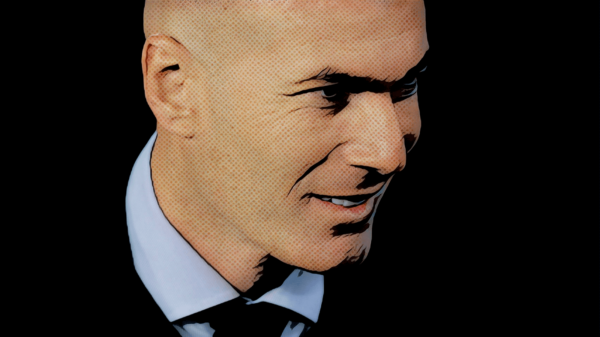James Sutherland writes a detailed tactical analysis about the La Liga match that ended Sevilla 2-1 Real Madrid.
For the third time in two weeks, Real Madrid and Sevilla met. The first two meetings were in the Copa del Rey, where Real advanced 6-3 on aggregate. Zinedine Zidane’s team had handled Sevilla, coached by Jorge Sampaoli, in the first leg, winning 3-0 at the Bernabeu. In the second leg Real had clawed back two goals, down 3-1, to secure a 3-3 draw and proceed.
Jorge Sampaoli and Sevilla entered this game with a massive chip, beyond avenging two close losses. A win would serve a double blow to Real: it would pull Sevilla just a point behind the Madrid team in the league table, and it would end a 40 game streak without a loss for Real, the longest in Spanish history.
Sampaoli and Sevilla finally got their revenge, scoring two goals in the last 10 minutes to pull Real’s title bid back and sink their unbeaten run. The match was dramatic and intense, with a great atmosphere provided by the home fans. It was an equal fight, with both teams putting in superb defensive performances.
Line Ups:

Made using TacticalPad
Real (3-5-2): Navas; Nacho, Ramos, Varane; Marcelo, Kroos, Casemiro, Modric, Carvajal; Ronaldo, Benzema
Sevilla (4-2-3-1): Rico; Escudero, Rami, Pareja, Mariano; N’zonzi, Iborra; Vitolo, Nasri, Vazquez; Ben Yedder
Real slow the game down
Sampaoli often seeks to make games as open and chaotic as possible. With uber-physical, athletic players like Arturo Vidal, Alexis Sanchez and Steven N’Zonzi, Sampaoli’s teams thrive in the chaos, the transition periods between set offense and defense. This is not to say that first Chile and now Sevilla under Sampaoli were inept in possession or defense; in fact, Sampaoli’s positional play is strong and well rounded, and his teams are strong in the defensive phase. Those just are not the optimal phases for Sampaoli teams.
Zidane clearly recognized this strength and sought to counter it as best he could. Instead of allowing the game to become open and helter-skelter, Zidane had Madrid throw a blanket on the match. Real were able to impose their own pace on the game, and force Sevilla to play much slower than they wanted, by sitting deep, with a 5-man defense, and cutting off any option for Sevilla to progress the ball.
Real chose not to press Sevilla’s build up out of concern for speeding the tempo of the game and allowing Sevilla space to build quickly, counter attacking with possession. Instead, the Madridistas sat in a passive block in the middle of the field, conceding the first third to Sevilla but denying them access to the middle or final thirds. Most often, this block took the form of a narrow, centrally focused 5-3-2, with Ronaldo and Benzema up top. Neither striker sought to press or direct Sevilla’s build up other than simply sitting in the center and denying a passing option down the middle. Real would also shift into a 5-1-3-1 or 5-4-1, with Casemiro sitting deeper as a holding midfielder, in front of the defense. Real defended, regardless of formation, in a more position-orientated fashion, staying in formation and shifting accordingly. However at times players, such as Casemiro down the center, and both Marcelo and Carvajal at wingback, would step out of formation to respond to Sevilla’s movements. This was crucial, especially for the wingbacks, as Sevilla often sought to build overloads in the halfspaces and wings.
Real’s defense successfully neutralized Sevilla’s possession, in addition to slowing the game down. They were able to do this for several reasons. First, Real’s narrow, compact 5-3-2 was able to force Sevilla’s possession to the wings. Although Real was passive in defense, they blocked off passing options through the center, forcing Sevilla’s play outside. Sevilla played into this strategy somewhat by relying heavily on the wings and halfspaces for progression. They mainly looked to move the ball down the right wing, where N’zonzi, Samir Nasri, Sergio Escudero and Vitolo formed a square. You can see that below, on the pass map 11tegen11 created for the match.

Image via 11tegen11
Most often, the four lined up as a square, with Nasri and Vitolo on Real’s last line, and N’zonzi and Escudero deeper. However sometimes the four would shift, often to balance Nasri’s movements. Sampaoli has granted Nasri great positional freedom throughout the season, and often times Nasri plays more in the deep half spaces, like Xavi or Iniesta would, than he does in the 10 space, where he is nominally supposed to. To balance Nasri’s deeper movements, Vitolo would often move inside, with Escudero moving up the wing and N’zonzi occupying the center. This created a diamond, offering far better options for progressing the ball past Real. This was a rare occurrence, however.
The square on the right wing, where most of Sevilla’s possession was focused (as you can see above), was flawed for a few reasons. Most importantly, the players were not staggered well. Escudero and N’zonzi are occupying the same horizontal line, as are Vitolo and Nasri. This lack of staggering made it easy for Real to retain their shape and cover the forward passing options. This square also left the ball at the feet of Escudero too much, a player who is not as effective in possession as Nasri or N’zonzi.
In addition to the compactness of their defense, the individual defensive instincts and abilities of several of Real’s defenders were crucial in stalling Sevilla’s possession. Raphael Varane, Sergio Ramos and Casemiro were all superb, showing excellent senses of timing and positioning. All three intervened in crucial moments of Sevilla’s play, stealing away a dangerous pass or closing down an open option many times. Sevilla should have exploited Real’s reliance on individuals defensively, by overloading Casemiro in the center and by pulling Varane or Ramos out of formation. However, Sampaoli’s team was unable to do this, partly due to the fact that they did not start a striker, instead playing Wassam Ben Yedder up front. Ben Yedder was granted free range positionally, and floated around the field. Without a player occupying Ramos centrally, Real’s captain was free to leave the backline and intervene in dangerous situations. Since Real were playing a back 5, Ramos’ roaming didn’t leave open gaps. Furthermore, Sevilla were unable to overload Casemiro or Varane, despite having many floating players.
Real’s defense did a fantastic job stifling Sevilla, normally a prolific attacking team. Zidane’s team limited Sevilla to just 0.45 expected goals, an incredibly low sum that reflects the lack of chances Sevilla were able to create (credit 11tegen11 for the xG sum). Futhermore, from the 53rd to 83rd minute Sevilla did not take single shot. Real shut Sevilla’s attack down.
Sevilla Throw a Blanket on Real
Despite Sevilla’s flawed play in possession, they did an incredible job blanketing Real’s counter attacking offense. Steven N’zonzi was central to this.
Fair to say that Steven N’Zonzi is the best La Liga midfielder this season? pic.twitter.com/89l9GlbG7l
— allasFCB (@allas4) January 16, 2017
N’zonzi was superb in this game, as he has been all season. The French midfielder is just the sort of player Sampaoli loves: physical, dominant and skillful. His size and strength enable him to control the midfield in defense, as he did in this game. His most important contributions come in defensive transition, when opponents are counter attacking. N’zonzi is a one man counterpressing machine. N’zonzi has the strength to force players off the ball, and his long legs eat up ground, allowing him to chase down any player, even Ronaldo in the clip above. Offensively N’zonzi also plays a crucial role, as a deep playmaker. His passing ability is fantastic, and he has strong positional awareness. These traits allow him to play an anchoring role for Sevilla’s buildup.
In this match N’zonzi was key in shutting down Real’s counter attack. With the devastating front three of Ronaldo, Benzema and Bale (although Bale was injured for this match), Real can cut nearly any team apart on the counter attack. Many teams do not have the speed, system, or both to counterpress Real’s front three. Sevilla do. While their possessional play was flawed, it set them up to counterpress well. With what was often a 2-4-4, Sevilla had the right balance of players spaced well over the field to apply pressure on the ball, and cut off forward options, whenever Real won the ball. Since Real did not press high and sat deep instead, they often took the ball off Sevilla inside their own half, making it easier for Sevilla to counterpress them.
Even when Real was able to breakthrough Sevilla’s pressure and get the ball to either Ronaldo or Benzema, they still struggled to mount a counterattack. Real simply could not escape the reaches of N’zonzi, who hunted down any potential counter and either won the ball back, or forced Real to pull back into set possession.
Once Real got into stable possession Sevilla continued to shut down their offense. Sevilla played a heavily man-orientated 4-2-3-1 in defense, so much so that at times it look like a 3-3-4, with a diamond on top. This man-orientated system did a good job cancelling the individual abilities of Real’s stars, including Kroos, Modric and Ronaldo, and since Real’s system is flawed and very basic, Madrid lacked the capacity to exploit the man-orientation to open up space.
Conclusion
Both teams effectively cancelled the other’s defense out. Sevilla only created 0.45 expected goals, and without their penalty Real created just 0.84. Real, however, will still feel disappointed with this result. They led for much of the second half, and turned in a great defensive performance. However, as Zidane noted (somewhat incorrectly), Real did not focus for five minutes, at the end of the match, and allowed Sevilla to score two goals.
Sevilla, on the other hand, picked up a massive and somewhat lucky win. They struggled offensively throughout the match, but came through when they most needed to. This win reignited the title race, leaving Real just one point up on Sevilla and two on Barcelona. For Sevilla it was about more than just the table; it was a statement, proving they have the quality to run with the two giants of Spanish football. The end of this season is going to be fantastic.
Read all our tactical analyses here
- Tactical Analysis: Sevilla 2-1 Real Madrid | Sevilla finally end the unbeaten streak - January 21, 2017
- Tactical Analysis: Borussia Dortmund 8-4 Legia Warsaw | Defence thrown out of the windows - November 27, 2016
- Tactical Analysis: RB Leipzig 1-0 Borussia Dortmund | Leipzing outpress Dortmund - September 18, 2016


























































